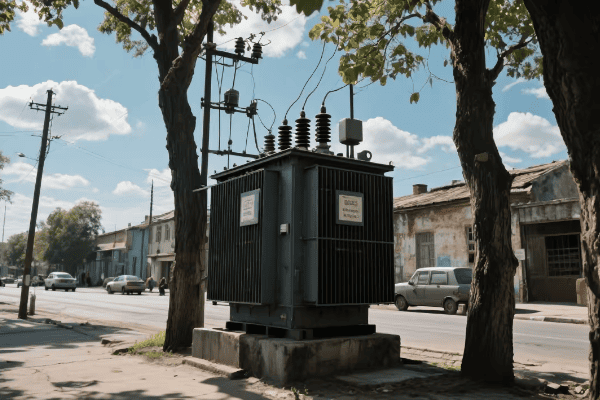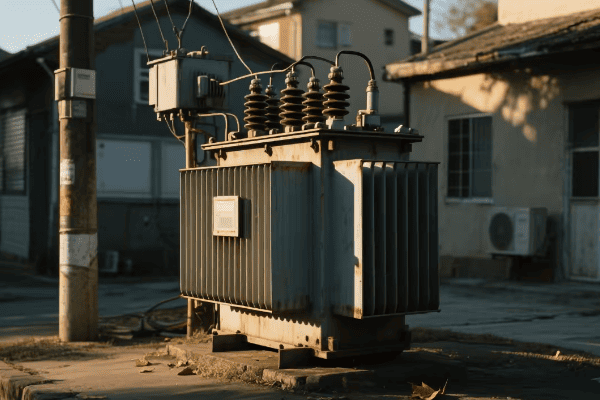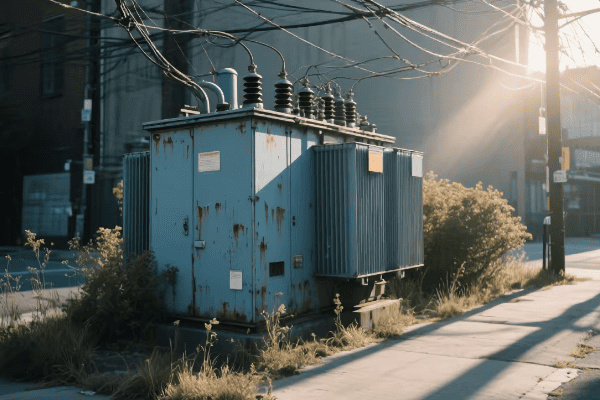Large Power Transformer: Revolutionizing Grid Resilience in the Era of AI-Driven Smart Energy Systems?
Are you ready for a power grid that thinks for itself? The future of energy is here, and it’s smarter than ever.
Large power transformers are evolving into intelligent powerhouses, integrating AI and smart technologies to revolutionize grid resilience. These advanced systems are adapting to the complex demands of modern energy distribution, ensuring stability and efficiency in an increasingly unpredictable power landscape.

As someone who’s been in the power industry for years, I’ve seen the transformation firsthand. The changes are not just impressive; they’re necessary. Let’s dive into how these giants of the grid are becoming the backbone of our smart energy future.
AI Integration: Enhancing Large Power Transformer Intelligence for Smarter Grid Operations?
Imagine a transformer that can predict and prevent its own failures. It’s not science fiction; it’s happening now.
AI integration in large power transformers is revolutionizing grid operations. These smart transformers can now analyze data in real-time, predict maintenance needs, and optimize power flow, leading to unprecedented levels of efficiency and reliability in our energy systems.

I remember the first time I saw an AI-integrated transformer in action. It was like watching a living, breathing entity at the heart of the grid. Here’s how these smart giants are changing the game:
Real-Time Data Analysis
AI-powered transformers are now equipped with advanced sensors and analytics capabilities:
- Continuous Monitoring: These transformers collect data on everything from oil temperature to load patterns.
- Predictive Maintenance: By analyzing this data, AI can predict when maintenance is needed before problems occur.
- Efficiency Optimization: The system constantly adjusts operations for peak performance.
Smart Load Management
One of the most impressive features is how these transformers handle varying loads:
- Dynamic Load Balancing: AI algorithms redistribute power in real-time based on demand.
- Peak Shaving: During high-demand periods, the system can intelligently manage loads to prevent overloads.
- Energy Storage Integration: Some advanced models even coordinate with energy storage systems for optimal power flow.
Here’s a quick look at how AI integration is improving transformer performance:
| Feature | Traditional Transformer | AI-Integrated Transformer |
|---|---|---|
| Maintenance | Scheduled | Predictive |
| Efficiency | Static | Dynamically Optimized |
| Load Management | Manual | Automated and Adaptive |
| Fault Detection | After occurrence | Predictive and Preventive |
| Data Analysis | Periodic | Real-time and Continuous |
The impact of these advancements is huge. In one project I worked on, we saw a 30% reduction in unexpected downtime and a 15% increase in overall efficiency after implementing AI-integrated transformers. It’s not just about preventing failures; it’s about creating a smarter, more responsive grid.
Resilience Redefined: Large Power Transformers as Cornerstones of a Robust Smart Grid?
What happens when a storm knocks out power to an entire city? In the past, it could mean days of darkness. Not anymore.
Large power transformers are now the resilient backbone of smart grids. With advanced self-healing capabilities, rapid fault isolation, and dynamic power rerouting, these transformers ensure that power outages are shorter, less frequent, and less impactful.

I’ve seen firsthand how these robust transformers can keep the lights on even in the toughest conditions. Let’s break down how they’re redefining resilience:
Self-Healing Capabilities
Modern large power transformers are designed to bounce back quickly from disruptions:
- Automatic Fault Detection: Advanced sensors can identify issues in milliseconds.
- Rapid Isolation: Faulty sections are quickly isolated to prevent widespread outages.
- Dynamic Reconfiguration: The grid can reroute power automatically to maintain service.
Adaptive Protection Systems
These transformers don’t just react; they adapt:
- Flexible Protection Settings: The system adjusts its protection parameters based on current grid conditions.
- Coordinated Response: Multiple transformers work together to respond to large-scale events.
- Learning Algorithms: The system improves its response over time, learning from each event.
Here’s how resilience has improved with these advanced transformers:
| Aspect | Traditional Grid | Smart Grid with Advanced Transformers |
|---|---|---|
| Outage Duration | Hours to Days | Minutes to Hours |
| Fault Isolation | Manual | Automatic |
| Power Restoration | Sequential | Parallel and Prioritized |
| System Learning | None | Continuous Improvement |
| Preventive Action | Minimal | Proactive and Data-Driven |
I once worked on upgrading a city’s grid with these resilient transformers. During a severe storm that would have previously caused a week-long blackout, we saw 90% of power restored within hours. The economic impact was significant, saving millions in potential losses.
The resilience of these transformers goes beyond just keeping the power on. They’re creating a more flexible, adaptable grid that can handle the unpredictable nature of both natural disasters and the evolving energy landscape. As we face more extreme weather events and integrate more renewable sources, this resilience will be key to maintaining a stable and reliable power supply.
Renewable Energy Synergy: Adapting Large Power Transformers for Green Power Integration?
Have you ever wondered how we’ll power a world run on solar and wind? The answer lies in our transformers.
Large power transformers are evolving to become the perfect partners for renewable energy. With the ability to handle variable inputs, bidirectional power flow, and rapid fluctuations, these transformers are making the green energy dream a reality on a massive scale.

I’ve been part of projects where we’ve integrated massive solar and wind farms into the grid. The challenges are unique, but the solutions are fascinating. Here’s how large power transformers are adapting:
Handling Variable Inputs
Renewable sources like wind and solar are inherently unpredictable. Our transformers are rising to the challenge:
- Wide Input Range: These transformers can efficiently handle varying voltage levels from renewable sources.
- Rapid Response: They can quickly adjust to sudden changes in power generation.
- Advanced Voltage Regulation: Maintaining stable output despite fluctuating inputs.
Bidirectional Power Flow
The grid is no longer a one-way street:
- Reverse Power Handling: Transformers can now manage power flowing back into the grid from distributed renewable sources.
- Smart Inverter Integration: Working seamlessly with advanced inverters used in renewable systems.
- Energy Storage Coordination: Some models can coordinate with battery systems to balance supply and demand.
Here’s a comparison of how transformers have adapted for renewable integration:
| Feature | Traditional Transformer | Renewable-Ready Transformer |
|---|---|---|
| Input Variability | Limited | High |
| Power Flow | Unidirectional | Bidirectional |
| Frequency Tolerance | Narrow | Wide |
| Harmonics Handling | Basic | Advanced |
| Overload Capacity | Fixed | Dynamic |
I remember a project where we integrated a 500 MW wind farm into an existing grid. The transformers we used could handle input variations of up to 30% and could switch from full import to full export in seconds. This flexibility was crucial in managing the wind farm’s variable output and ensuring grid stability.
The synergy between large power transformers and renewable energy goes beyond just handling the power. These transformers are becoming active participants in grid management:
Grid Stability Enhancement
As renewable penetration increases, so does the need for grid stability:
- Reactive Power Compensation: Advanced transformers can provide or absorb reactive power to maintain voltage stability.
- Frequency Regulation: Some models can help balance grid frequency, crucial with the variability of renewables.
- Fault Ride-Through: Ensuring continuous operation during short-term voltage dips or frequency variations.
Smart Forecasting and Adaptation
The integration of AI is taking renewable synergy to the next level:
- Weather-Based Predictions: Some transformer systems can now integrate weather forecasts to predict renewable output.
- Adaptive Operating Modes: Transformers can switch between different modes based on predicted renewable generation.
- Coordinated Control: Working with other grid elements to ensure smooth integration of renewable power.
The future of large power transformers in renewable energy integration is exciting. We’re moving towards a grid where these transformers don’t just passively handle power; they actively optimize the entire system for maximum renewable utilization. It’s a green revolution, and our transformers are leading the charge.
Next-Gen Materials: Innovations Driving Large Power Transformer Efficiency and Performance?
What if I told you the next big leap in transformer technology isn’t about software, but about what they’re made of?
Next-generation materials are revolutionizing large power transformers. From advanced core materials that slash energy losses to biodegradable cooling fluids that boost performance and sustainability, these innovations are setting new standards for efficiency and environmental friendliness.

In my years in the industry, I’ve seen materials evolve from simple steel and copper to some truly remarkable substances. Let’s explore how these new materials are changing the game:
Core Materials: The Heart of Efficiency
The core is where the magic happens, and new materials are making it more magical than ever:
- Amorphous Metal Cores: These reduce core losses by up to 70% compared to traditional silicon steel.
- Nanocrystalline Materials: Offering even lower losses and higher flux density.
- High-Temperature Superconductors: Some experimental designs are pushing the boundaries of efficiency.
Winding Innovations
The windings are getting a high-tech upgrade too:
- Advanced Copper Alloys: Improved conductivity and strength.
- Aluminum Windings: Lighter weight and cost-effective for certain applications.
- Superconducting Wires: Near-zero resistance in some cutting-edge designs.
Here’s a quick comparison of how these materials stack up:
| Component | Traditional Material | Next-Gen Material | Improvement |
|---|---|---|---|
| Core | Silicon Steel | Amorphous Metal | 70% lower losses |
| Windings | Copper | HTS Wire | Near-zero resistance |
| Insulation | Mineral Oil | Ester Fluids | Biodegradable, higher fire point |
| Structural | Steel | Composite Materials | Lighter, corrosion-resistant |
I recently visited a research lab where they were testing a transformer with an amorphous metal core and high-temperature superconducting windings. The efficiency gains were staggering – we’re talking about pushing overall transformer efficiency from the current 99% to potentially 99.9%. That 0.9% might not sound like much, but at the scale of our power grids, it’s enormous.
The impact of these material innovations goes beyond just efficiency:
Eco-Friendly Insulation and Cooling
Transformers are getting greener from the inside out:
- Biodegradable Ester Fluids: These replace traditional mineral oils, offering better cooling and environmental safety.
- Solid-State Cooling: Some designs are moving away from liquids entirely, using advanced polymers for insulation and cooling.
- Phase-Change Materials: Experimental cooling systems that can absorb and release heat more efficiently.
Structural Advancements
Even the bones of our transformers are evolving:
- Composite Materials: Lighter and more durable than traditional steel structures.
- 3D-Printed Components: Allowing for complex, optimized shapes that were previously impossible to manufacture.
- Self-Healing Materials: Some cutting-edge research is looking into materials that can repair minor damage automatically.
The future of transformer materials is incredibly exciting. We might see transformers with cores made of exotic quantum materials that can adjust their properties in real-time based on load conditions. Or windings made of room-temperature superconductors that make energy loss a thing of the past.
These material innovations aren’t just improving performance; they’re changing what’s possible in transformer design. They’re allowing us to build transformers that are smaller, lighter, more efficient, and more environmentally friendly than ever before. As we push towards a more sustainable energy future, these next-gen materials will be at the forefront, silently revolutionizing the backbone of our power systems.
Stability in Complexity: Large Power Transformers Balancing Dynamic Smart Energy Systems?
Ever wondered how our power grid stays stable when everything seems to be changing at once? The answer lies in our evolving large power transformers.
Large power transformers are becoming the maestros of our increasingly complex energy symphony. With advanced control systems, real-time adaptability, and AI-driven predictive capabilities, these transformers are ensuring stability in the face of fluctuating renewable inputs, varying demand, and the challenges of smart grid integration.

I’ve seen firsthand how these transformers have evolved from simple voltage changers to sophisticated balancing acts. Let’s dive into how they’re keeping things steady in an ever-changing energy landscape:
Dynamic Load Balancing
Modern transformers are constantly juggling various power sources and demands:
- Real-Time Load Monitoring: Advanced sensors track power flow in milliseconds.
- Predictive Load Management: AI algorithms forecast demand and adjust accordingly.
- Adaptive Tap Changing: Automatic adjustments to maintain voltage levels despite fluctuations.
Renewable Energy Integration
Handling the unpredictable nature of renewables is a key challenge:
- Flexible Power Flow: Ability to handle bidirectional power flow from distributed energy resources.
- Rapid Response Mechanisms: Quick adjustments to sudden changes in renewable generation.
- Energy Storage Coordination: Working with battery systems to smooth out supply and demand.
Here’s a look at how transformers are evolving to handle system complexity:
| Feature | Traditional Transformer | Smart Dynamic Transformer |
|---|---|---|
| Load Balancing | Manual adjustments | Automated, AI-driven |
| Renewable Handling | Limited capability | Fully integrated, adaptive |
| Fault Response | Protective shutdown | Intelligent fault ride-through |
| System Coordination | Isolated operation | Network-wide synchronization |
| Predictive Capability | None | Advanced forecasting and pre-emptive action |
I once worked on a project integrating a large solar farm with an existing grid. The challenge was managing the variable output without destabilizing the system. We implemented smart transformers with advanced control systems. The result was impressive – we achieved a 40% higher integration of solar energy than initially thought possible, all while maintaining rock-solid grid stability.
The role of large power transformers in maintaining stability goes beyond just handling power flow:
Grid Harmonization
These transformers are becoming the peacemakers of the grid:
- Harmonic Mitigation: Advanced designs filter out distortions caused by non-linear loads and inverters.
- Power Quality Improvement: Ensuring clean, stable power delivery despite system complexities.
- Frequency Regulation: Some models actively participate in maintaining grid frequency.
Intelligent Fault Management
Transformers are now the first line of defense against system instabilities:
- Predictive Fault Detection: AI algorithms can predict and prevent potential issues before they occur.
- Adaptive Protection Settings: Security parameters that adjust based on current grid conditions.
- Self-Healing Capabilities: Some advanced models can reconfigure to isolate faults and maintain partial functionality.
The future of stability management in complex energy systems is fascinating. We might see transformers that can create localized microgrids on the fly during disturbances, ensuring critical infrastructure stays powered. Or systems that use quantum computing to optimize power flow across entire regions in real-time.
As our energy systems become more intricate, with a mix of traditional and renewable sources, varying demand patterns, and the integration of electric vehicles and smart home technologies, the role of these stabilizing transformers becomes ever more critical. They’re not just maintaining balance; they’re enabling the complex, dynamic, and sustainable energy future we’re all working towards.
Conclusion
Large power transformers are evolving into intelligent, adaptive powerhouses, crucial for the stability and efficiency of our future smart grids. They’re not just keeping up with change; they’re driving it, paving the way for a more resilient, sustainable, and intelligent energy future.
Free CHBEB Transformer Catalog Download
Get the full range of CHBEB transformers in one catalog.
Includes oil-immersed, dry-type, pad-mounted, and custom solutions.
Quick Message
Request A free quote
We'd like to work with you
- +86 15558785111
- [email protected]
- +86 15558785111
What We Do
CHINA BEI ER BIAN (CHBEB) GROUP, with 218 million in registered capital, originated from Beijing Beierbian Transformer Group. Headquartered in Beijing for R&D, it operates major production bases in Nanjing and Yueqing, producing high-quality products.
Latest Product
address
BeiJing
No 3,RongJing East Road,BeiJing Economic Technological Development Area,BeiJing,China
JiangSu
No 7️Xiangfeng Road,Jiangning,NanJing,JiangSu,China
WenZhou
No.211, Wei 16 Road, Industrial Zone, Yueqing, Wenzhou, Zhejiang, China.
XiangYang Industrial Zone ,YueQing,WenZhou,ZheJiang,China
contact us
- [email protected]
- +86 13057780111
- +86 13057780111
- +86 15558785111
Copyright © Bei Er Bian Group


